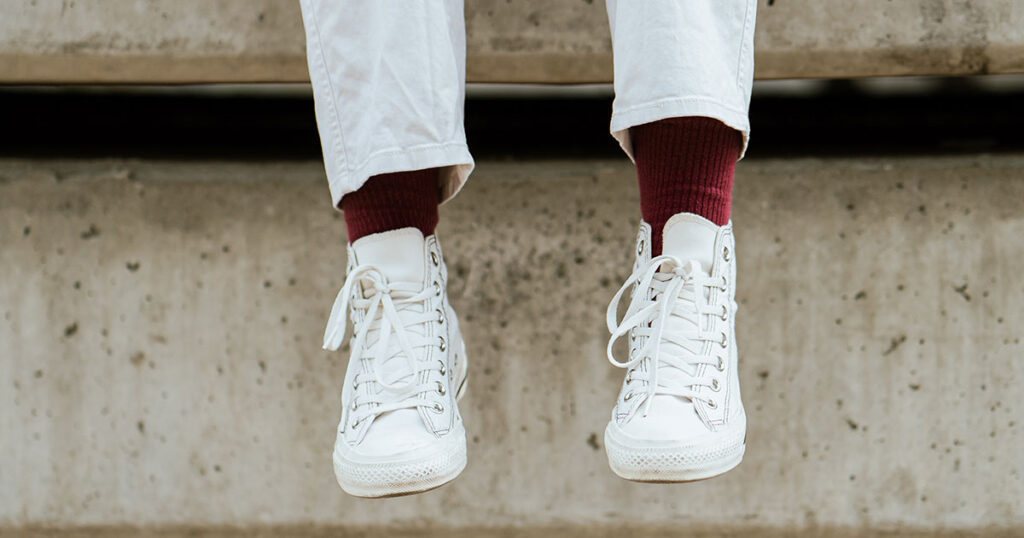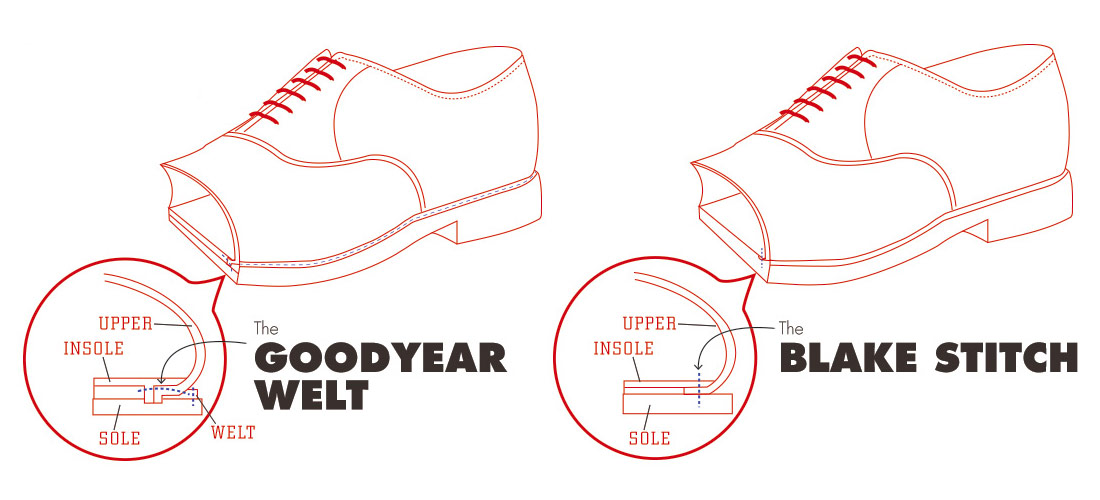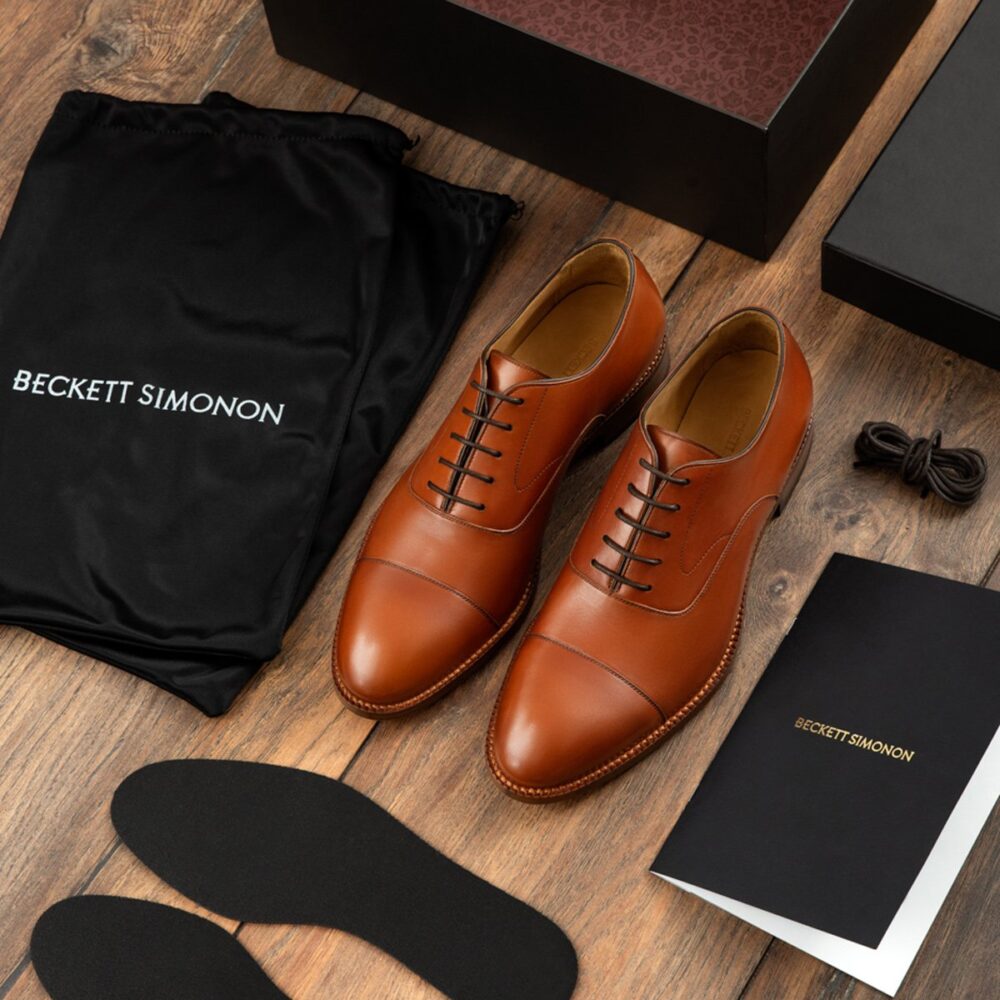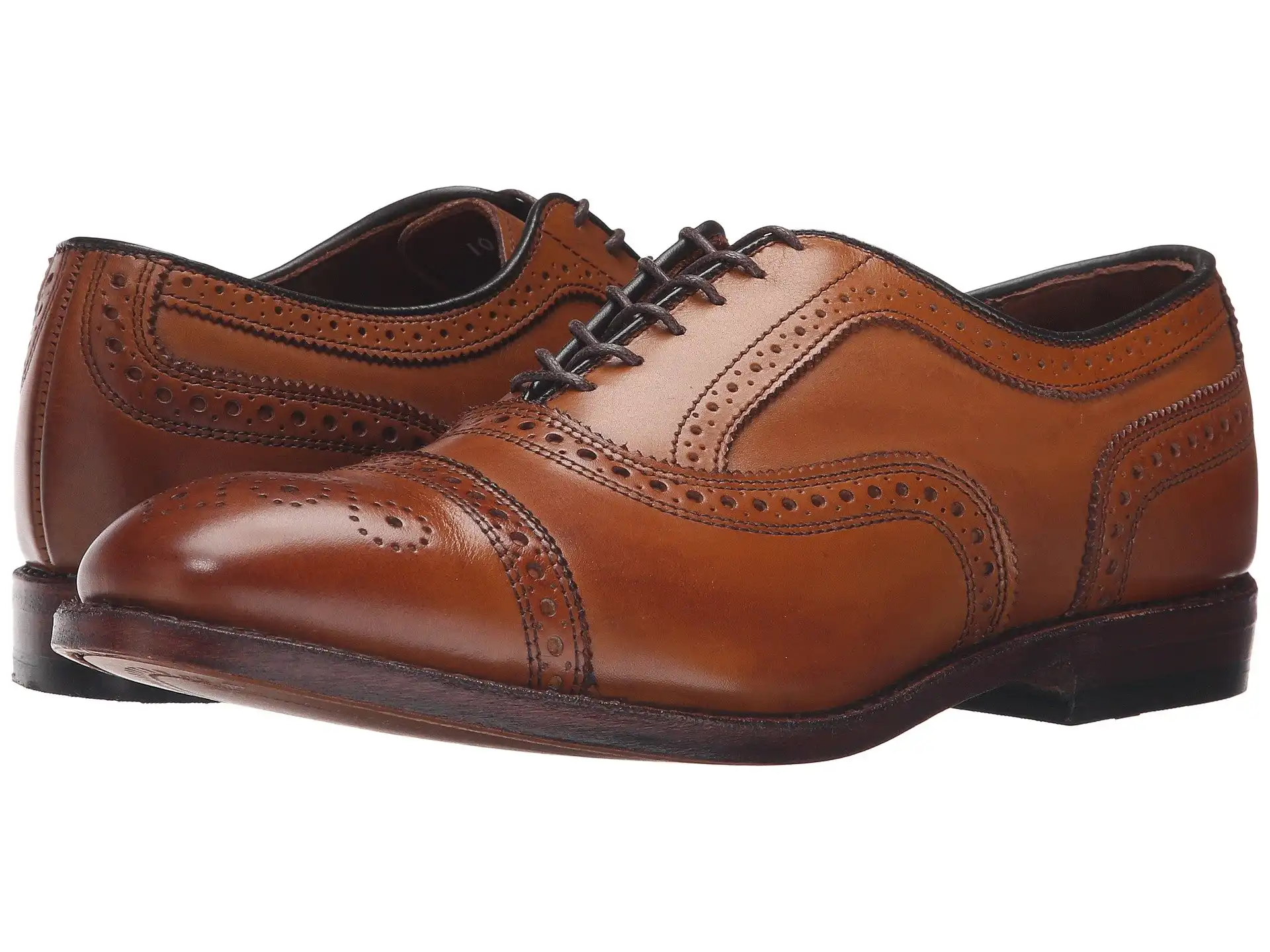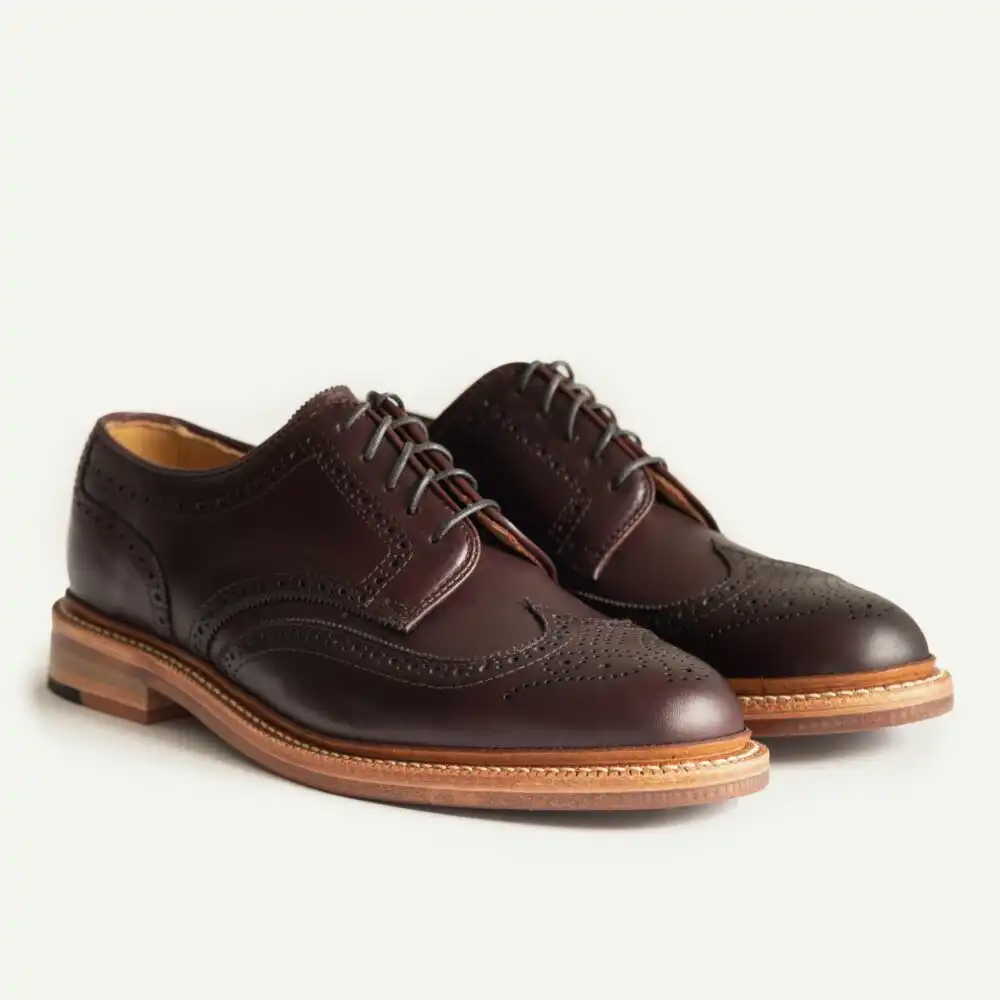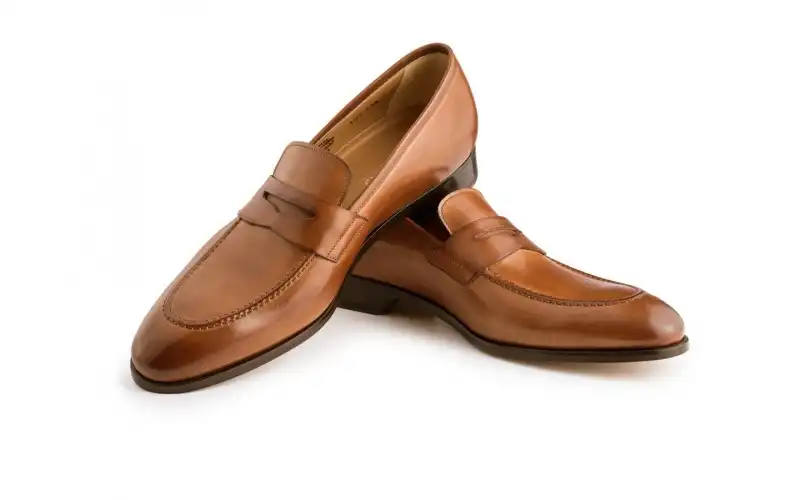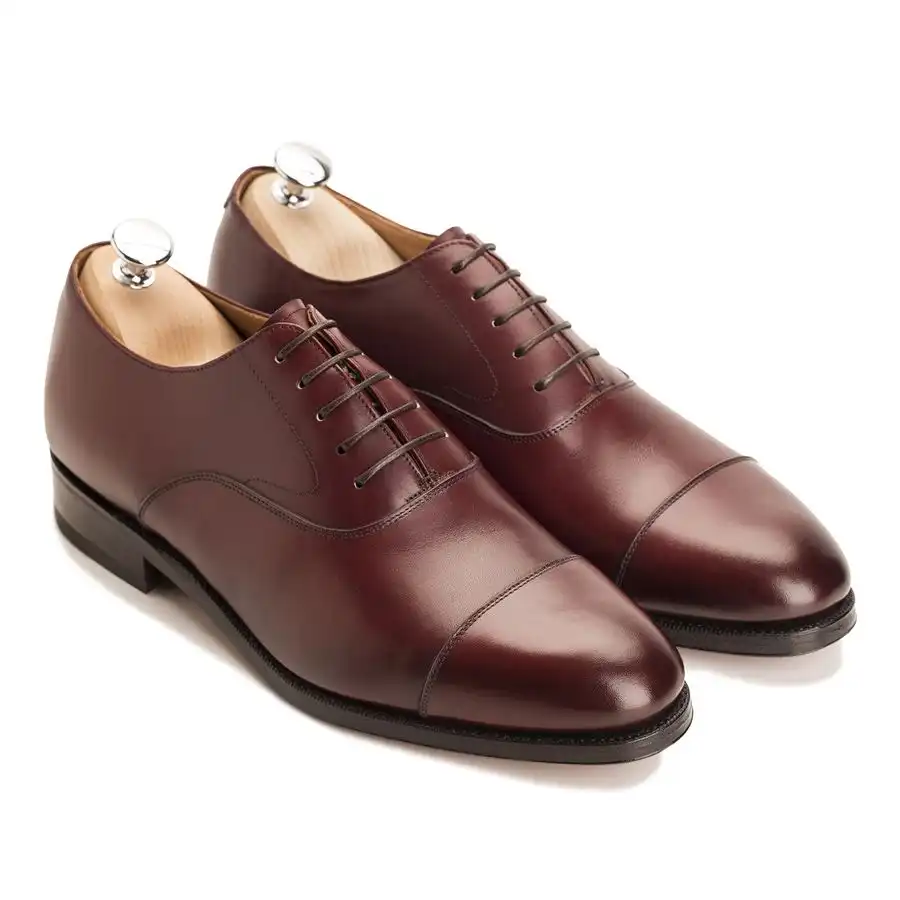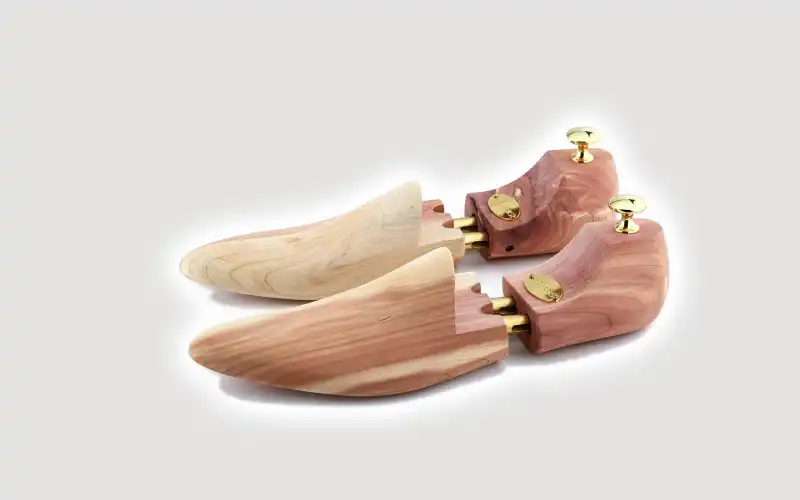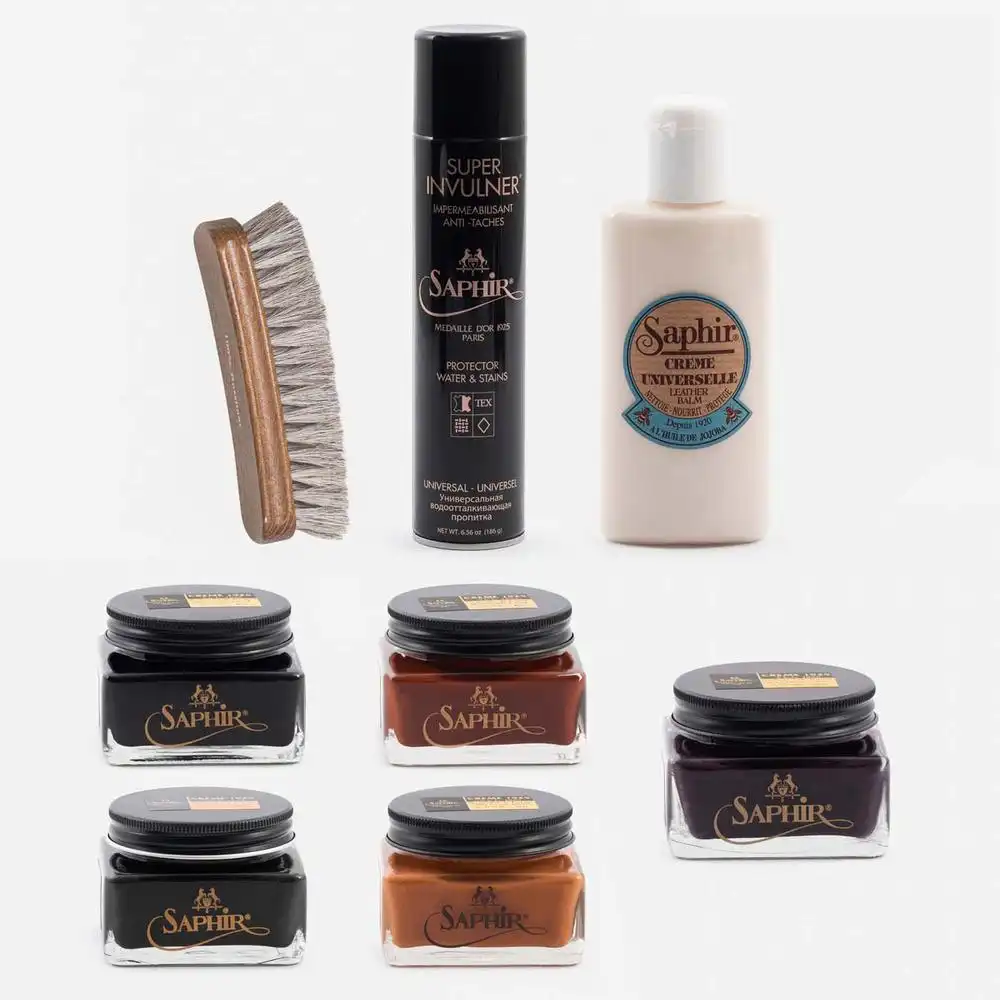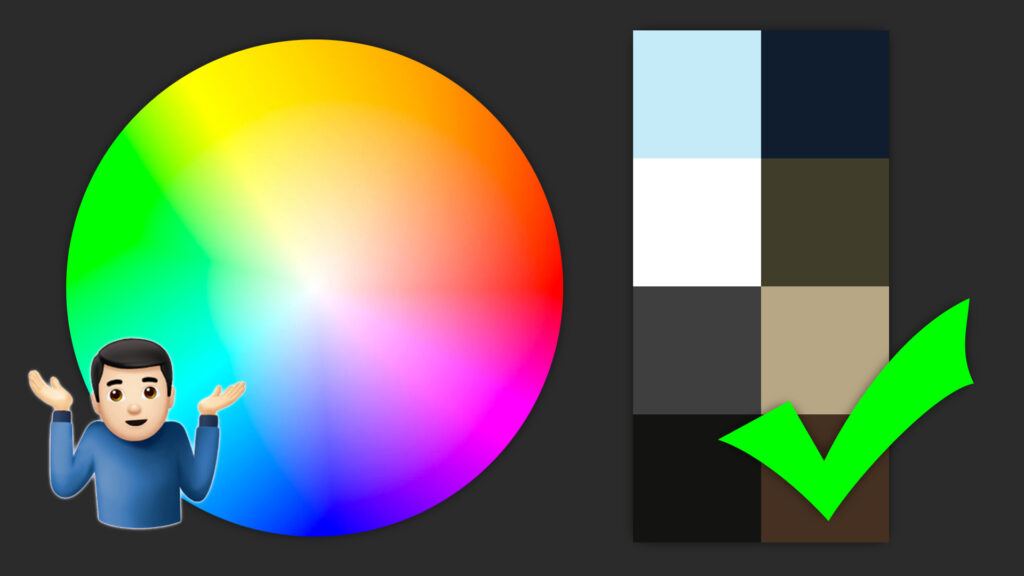Brown dress shoes in quality leather are a versatile and stylish essential in any man’s wardrobe.
But there are so many options. How can you find a pair that you love, looks great, and fits your budget?
Not all dress shoes are created equal. Just because they’re leather (or resemble leather), doesn’t mean you’re buying the right shoe… or that it’s going to fit the rest of your getup.
Add to that the massive array of options available to you.
(I dare you to search for “brown leather dress shoes” and not come away overwhelmed.)
KEEP THIS IN MIND
No idea what an SIS is? Pyramid what? If you’re still figuring out how to build a Lean Wardrobe, go over the articles on this resource page »
Oh, and if you’re concerned about how dressy or casual one of these items is, you need to study the Spectrum of Style Formality »
So many brands, colors, styles, and prices… how can you be sure you’re getting a pair that deserves a place in your Lean Wardrobe?
No worries. I’m going to help you find and buy the perfect pair of brown leather dress shoes.
Once you understand your options and know what you’re looking for, everything becomes much easier.
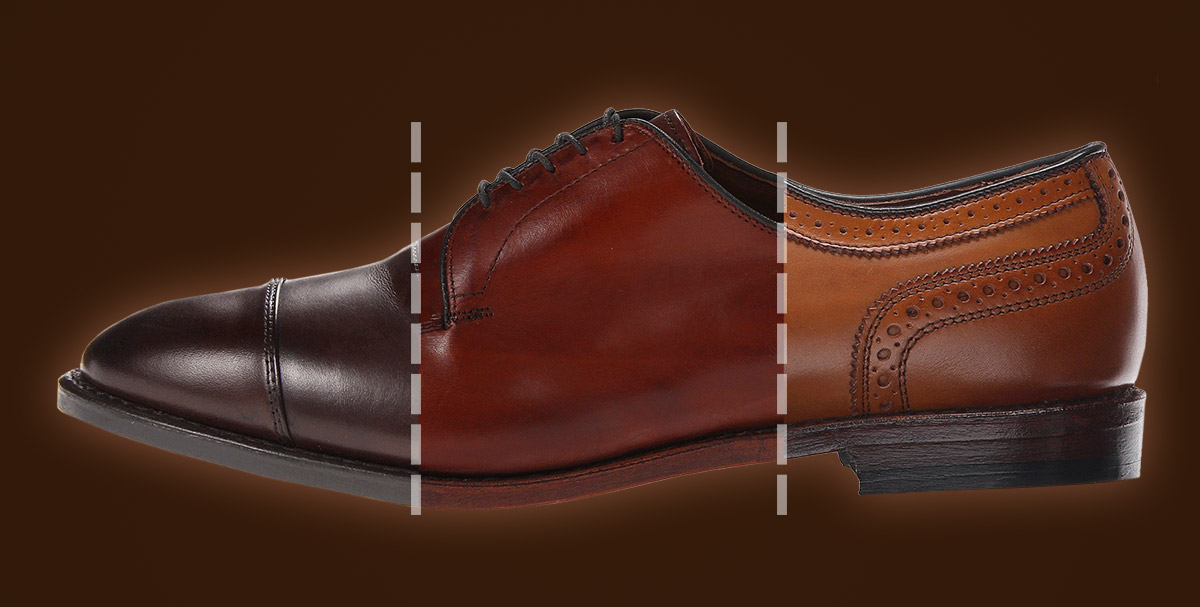
Are brown leather shoes better than black leather shoes?
Short answer: YES.
Longer answer: Yes, because 99% of the time, I wear some type of brown leather shoe. Why?
- Brown is richer, more interesting, and more versatile.
- Brown dress shoes can easily be dressed up and down.
- Brown shoes go with just about any
suiting color you might wear.
Sure, black dress shoes have their place in your wardrobe. But if you’re only going to have one killer pair of dress shoes, they should be brown. And if you wear leather dress shoes daily for work, I’d recommend you get more than one pair in brown.
Now that I’ve got you convinced, let’s move on to picking out the right pair. Here’s what we’ll be covering in this guide to brown dress shoes.
By the end you’ll be a shoe expert and have found the perfect pair of brown dress shoes for your style.
Different Styles of Brown Dress Shoes
Hit the shoe store – online or local – and you’re going to find an enormous number of brown dress shoe options. All kinds of shapes and styles, shades and tones, curves and soles.
Which is right for you? Consider two essential factors:
- Style – Go with a classic style and you’ll never have to replace your shoes. They’ll always be current and will easily match with your trendier items.
- Formality – Semi-formal shoes are most versatile. They fit in a formal outfit but can also be dressed down into a smart casual style.
I know what you’re thinking.
“Soo… what exactly does ‘classic’ and ‘semi-formal’ look like?”
Don’t worry, we’ll go over that.
But as we go through some common dress shoe designs, keep in mind these two factors. Don’t get distracted by shoes with great style but a formality that won’t work for your needs.
Let’s compare two of the most common styles of dress shoes: oxfords and bluchers.

Check This One Out, Too!
Oxford vs. Blucher
The main difference between the oxford (a.k.a. balmoral) and the blucher (a.k.a. derby or buck) is how the vamp is stitched.
With oxfords, the eyelets are stitched underneath the vamp. This creates a more formal look. Bluchers have eyelets stitched on top of the vamp and are considered slightly less formal.
See the following image:
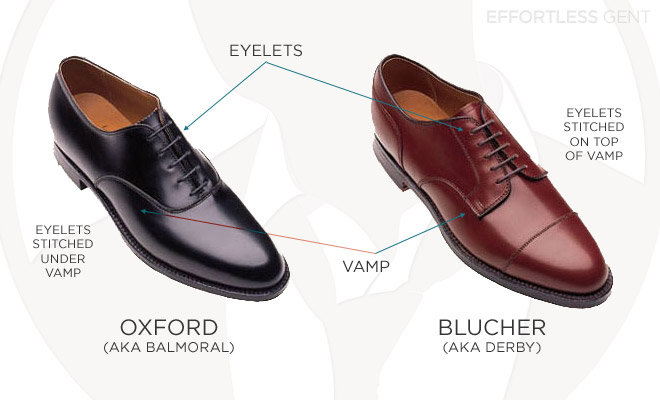
The other major factor that determines the formality of your dress shoes is toe design. A plain toe (like in the oxford above) is more formal than a cap toe (the blucher above).
Less formal still are any shoes with broguing – the decorative patterns of holes on some dress shoes. Originally these were made for aeration when your shoes got wet, but now it’s just for looks.

The rule of brown dress shoe formality goes like this:
- Oxford » Blucher
- Plain toe » Quarter brogue » Semi brogue » Full brogue
Confused about how casual or formal other clothes are, too? You’ll want to read this post: How to Mix and Match Casual And Dressy Clothes
- Ultra formal event? Plain toe oxford is your best choice.
- Casual Friday? Bust out the full brogue (or semi, or quarter, whichever you prefer).
- Have to choose just one? The semi- or full brogue…
…especially if you dress in a smart, sharp, casual style, the semi or full brogue is the best choice. They’ll go with everything from a navy suit to denim. (More on what to wear with your shoes below.)
Now that you’ve chosen the right style, let’s dive into all your color options.
Choosing the Best Shade of Brown Leather Shoes
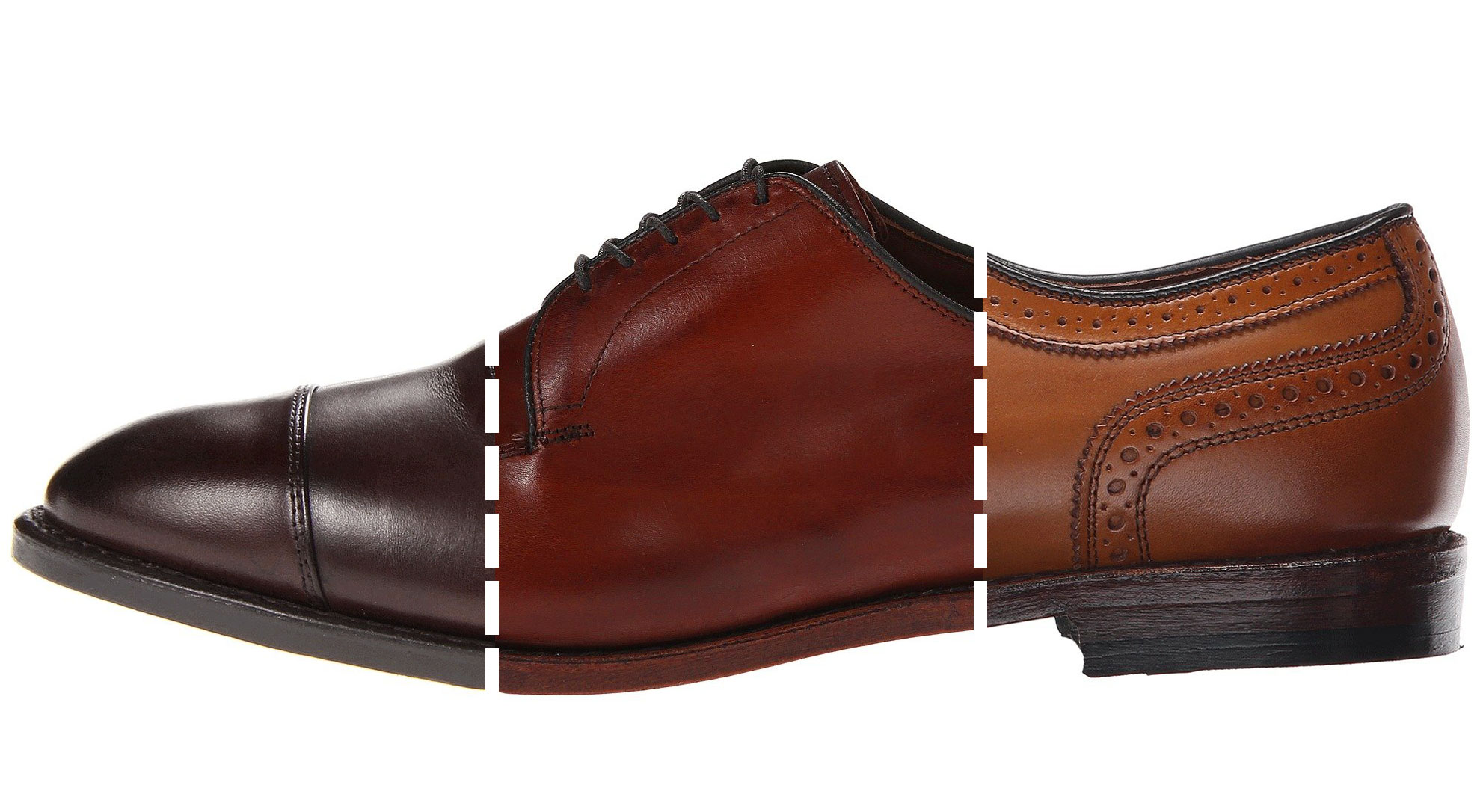
Wondering which shade of brown is best?
To be honest, it’s a matter of preference. But it also can depend on what best matches the rest of your outfit, and where you’re headed.
In general, the darker the shoe, the more formal it is.
Keep in mind that there isn’t one absolute, best color for your shoes (or anything else in life). And one brand’s take on “brown” may be slightly darker or lighter than another’s.
Instead of focusing so much on the specific color of each shoe you consider, think of which shade group it belongs to.
For brown, there are three main groups: light brown, standard brown, and burgundy.
Light Brown
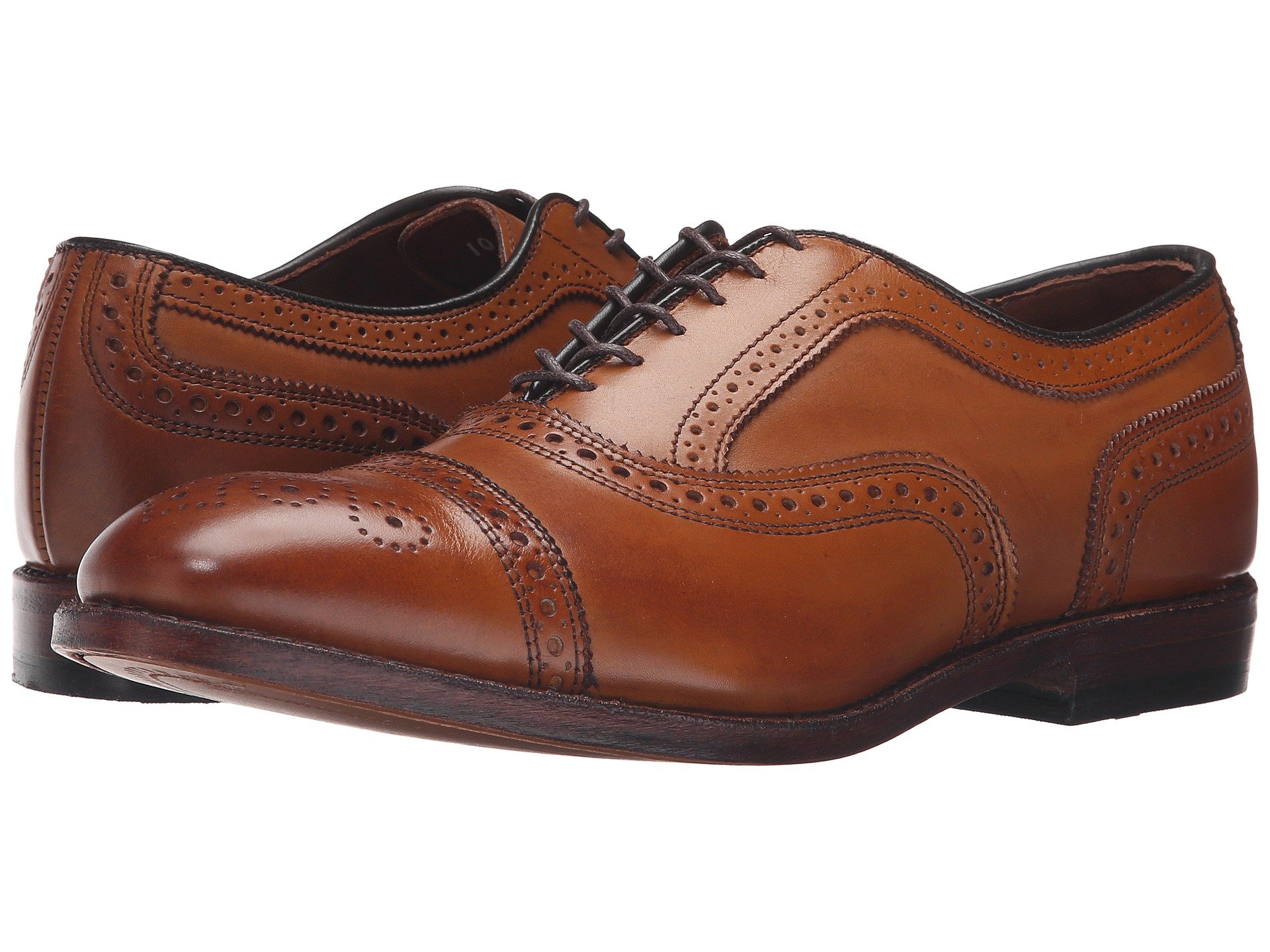
This shade group includes:
- Tan
- Cognac
- Walnut
- Neutral
- Bronze
Above is one of my personal favorites, the Allen Edmonds Strand in Walnut Calf.
I love it because it goes great with nearly everything—dark denim, charcoal
All light browns look similar to this, though they can vary slightly. No worries though; it’s hard to go wrong with such an eye-catching shade.
Standard Brown (medium to dark)
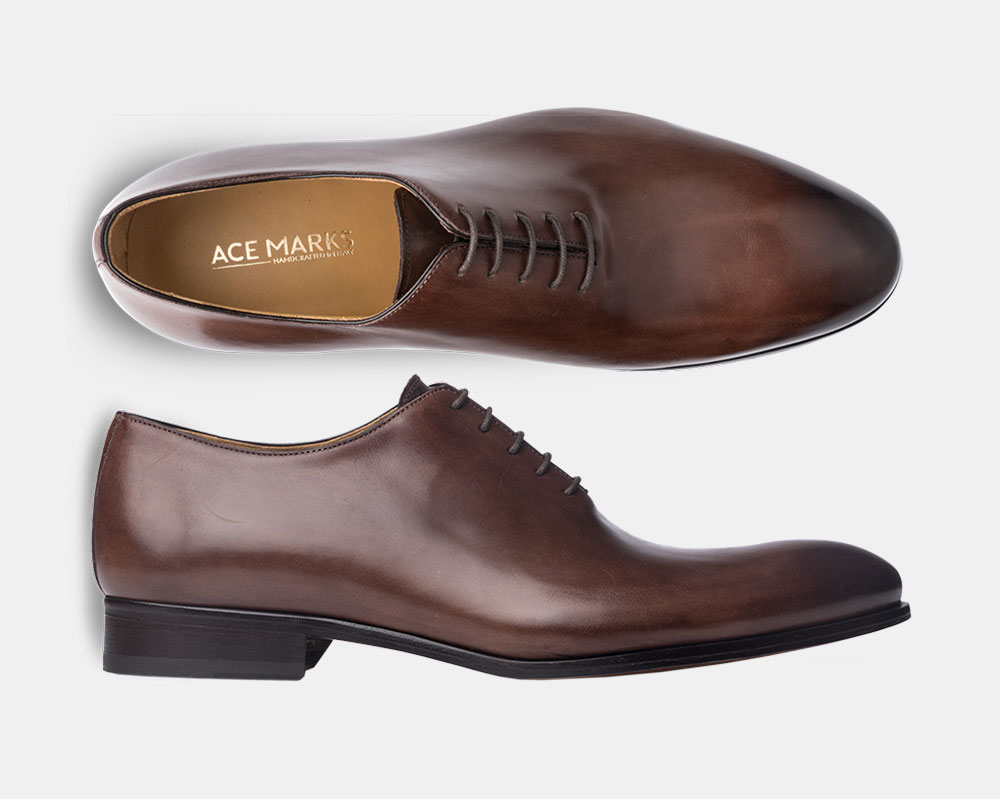
This shade group includes:
- Burnished Brown
- Medium Brown
- Dark Brown
- Mahogany
Darken things up a bit and you’ve got standard brown leather. This is the wholecut oxford in antique brown from Ace Marks.
Notice how there’s a little dark brown or black in this pair, especially at the toe?
Burnished leather gives the shoes an antiqued, buffed, worn-in look with darker shades of brown at the heel and toe. The darker tones add some dimension to the overall shoe color.
It’s a subtle thing, but at EG we’re all about the little details, and I like this one.
Even in the world of formal brown dress shoes, you can still find little flourishes of detail that make your shoes stand out.
Burgundy
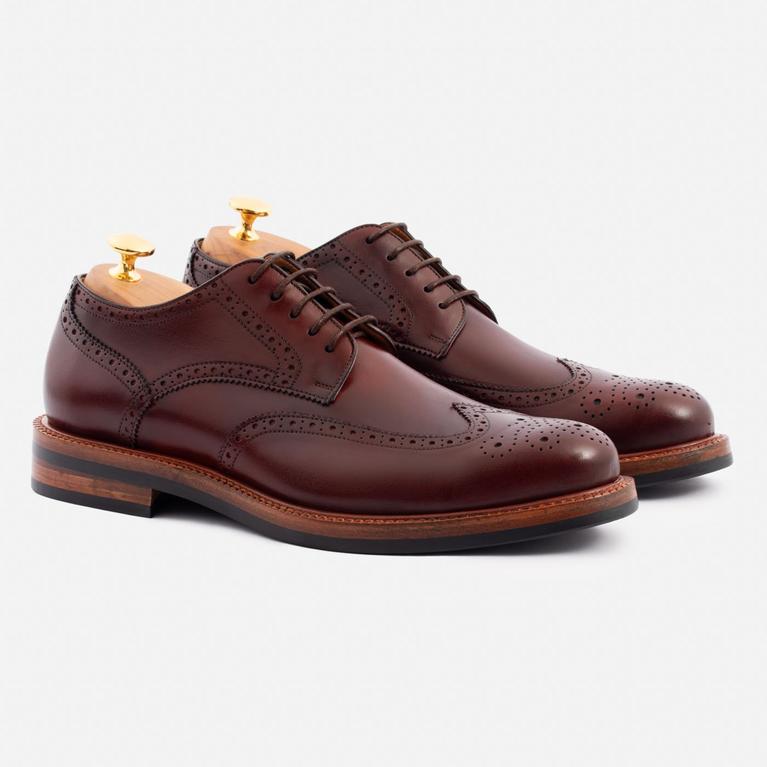
This shade group includes:
- Chili
- Bordeaux
Burgundy-colored leather looks similar to dark brown, but with hints of red.
These colors can vary depending on how the light hits them, making these shades some of the richest and most interesting. This is the Kent wingtip in Bordeaux from Beckett Simonon.
Burgundy (also known as chili or Bordeaux) shoes offer a nice alternative to standard brown leather. But depending on how picky you are, it may be challenging to match these shades to your pants.
Charcoal trousers, dark navy trousers, or muted khaki chinos (not too light) all look great with this color shoe.
The Bottom line: Which shade is best?
Consider the formality of your typical outfits. If you’re mostly formal, darker shades are best. For smart casual looks, medium to light brown is best.
Light browns (like cognac and tan) and burgundies can be really eye-catching, which is another thing to consider.
Dress Shoe Construction and Materials
We’ve discussed style and color. Those are factors most guys consider. It’s hard not to, since that’s what you immediately notice about shoes.
Now it’s time to address the shoe’s construction and materials. These are the details you don’t always see, but will definitely notice after years of wear.
Make sure you know enough about the materials and construction of dress shoes to make an informed purchase. Otherwise, you’ll waste money and wind up disappointed.
You’ll want to consider:
- the quality of the leather uppers
- the general construction of the shoe
- and the materials used in the sole
Leather
There are several grades of leather, from top quality to junk.
When shopping for shoes, you want to make sure you’re closer to the top than the bottom.
Here’s a visual of the difference between types of leather and what the names of common leather grades actually mean.
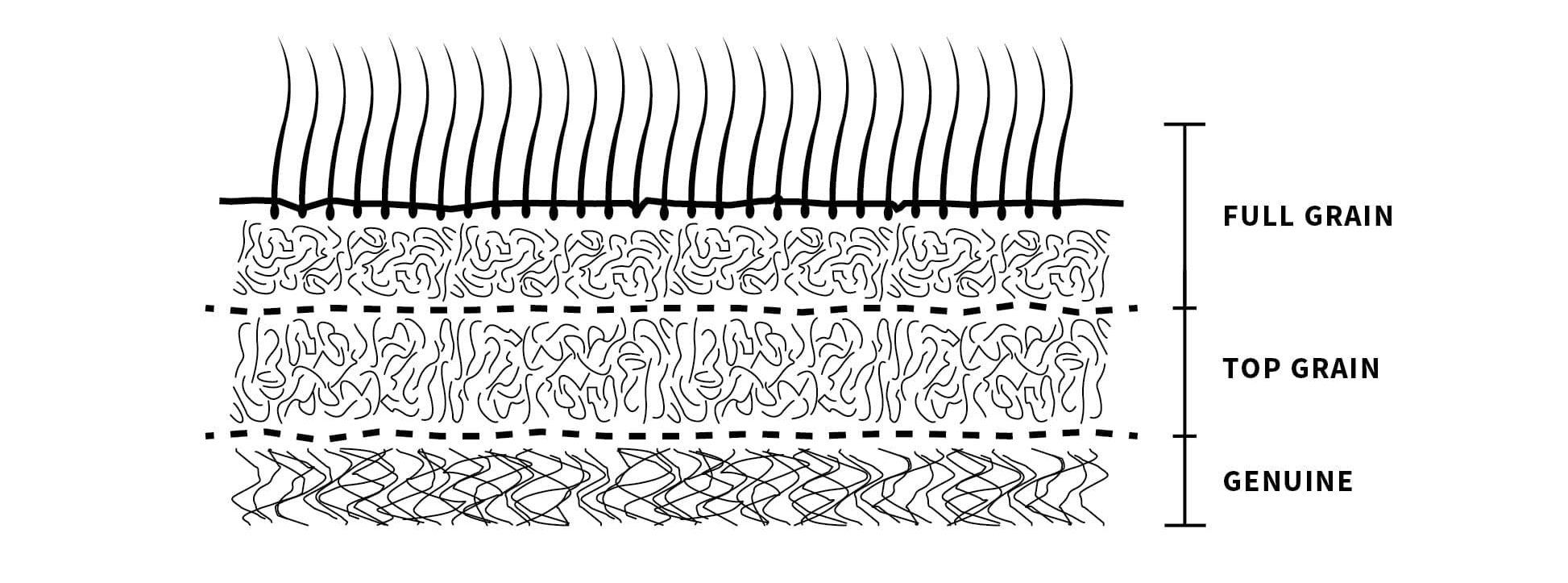
- Full Grain Leather – Full grain leather is top quality. It comes from smooth, untarnished hides that do not have to be sanded down. As it ages, it takes on a rich patina that makes your shoes look even better.
- Top Grain Leather – A bit thinner and easier to work with, top grain leather has a split layer. Any minor imperfections in the hide have been sanded away and the finish leaves it feeling smooth.
- Corrected Grain (or Genuine) Leather – The low-quality alternative. It’s still leather, sure. But it’s made from blemished hides that get sanded down and treated with chemicals. It’s then given an artificial grain and stained or dyed to make it look more like a full or top grain leather.
A few other variations to keep in mind:
- Shell Cordovan Leather – Made from one specific part of horsehide (not cow) and produced by just a few manufacturers around the world, shell cordovan leather is expensive and in high demand. Its patina is unmatched and, while you’ll pay a premium for it, you’ll have a pair of luxury dress shoes that will stand out every time you wear them.
- Pebbled Leather – The raised texture you find in some leather goods. It can be used to disguise poorer quality leather. Not all pebbled leather is low quality, however (you can have full grain leather with a pebbled texture)
Want a pair of shoes that will last you a lifetime? Full grain leather is the right choice.
It’s more porous than top grain leather, so it better absorbs polish and develops a richer patina. The result is a classic, stylish pair of dress shoes that will always impress.
On a budget? Tempted to go with corrected grain or genuine leather? Resist the urge.
The chemical finish and low quality material means it’s more likely to crease and crack. You’ll spend more on repeatedly replacing cheap shoes than you would investing in one pair of full grain leather dress shoes.
But even the best quality leather is no good if the shoe itself isn’t built for comfort and longevity. That’s why the shoe’s construction matters too.
Construction
There are three common types of shoe construction: Goodyear welting, Blake stitching, and cementing.
Each is a different approach to how the leather upper is attached to the sole. The one you choose will affect the appearance and durability of your dress shoes.
- Goodyear Welting – A leather welt (or strip) is used to stitch together the upper and the outsole. This makes it easy to resole the shoes without damaging them. The insole and outsole are separated by a layer of cork which conforms to your foot over time.
- Blake Stitching – The upper is stitched directly to the insole and outsole of the shoe. The look is smooth and streamlined since no leather welt separates the shoe’s components. However, this makes it easier for water to get into the shoe and complicates the resoling process.
- Cementing – A cheap, inferior way to make shoes. The cement dries up with time and the shoe’s upper separates from the sole. This method is best used on casual shoes that are not designed to last more than a few years. Note that some cemented dress shoes can have decorative stitching to make it seem like a different method was used… don’t be fooled. To make sure the stitching is authentic, check that the bottom and top stitches align.
Both Goodyear welting and Blake stitching have their respective benefits. And both are sturdy methods of construction. Either one will make for a beautiful, long lasting pair of dress shoes that can be recrafted when necessary.
Sole
The sole of your shoe doesn’t get as much visual attention as the leather upper, but it shouldn’t be overlooked. A quality sole makes every step you take in your dress shoes better.
These are the most common types of soles used in dress shoes, their differences, and how to choose the right kind for your footwear.
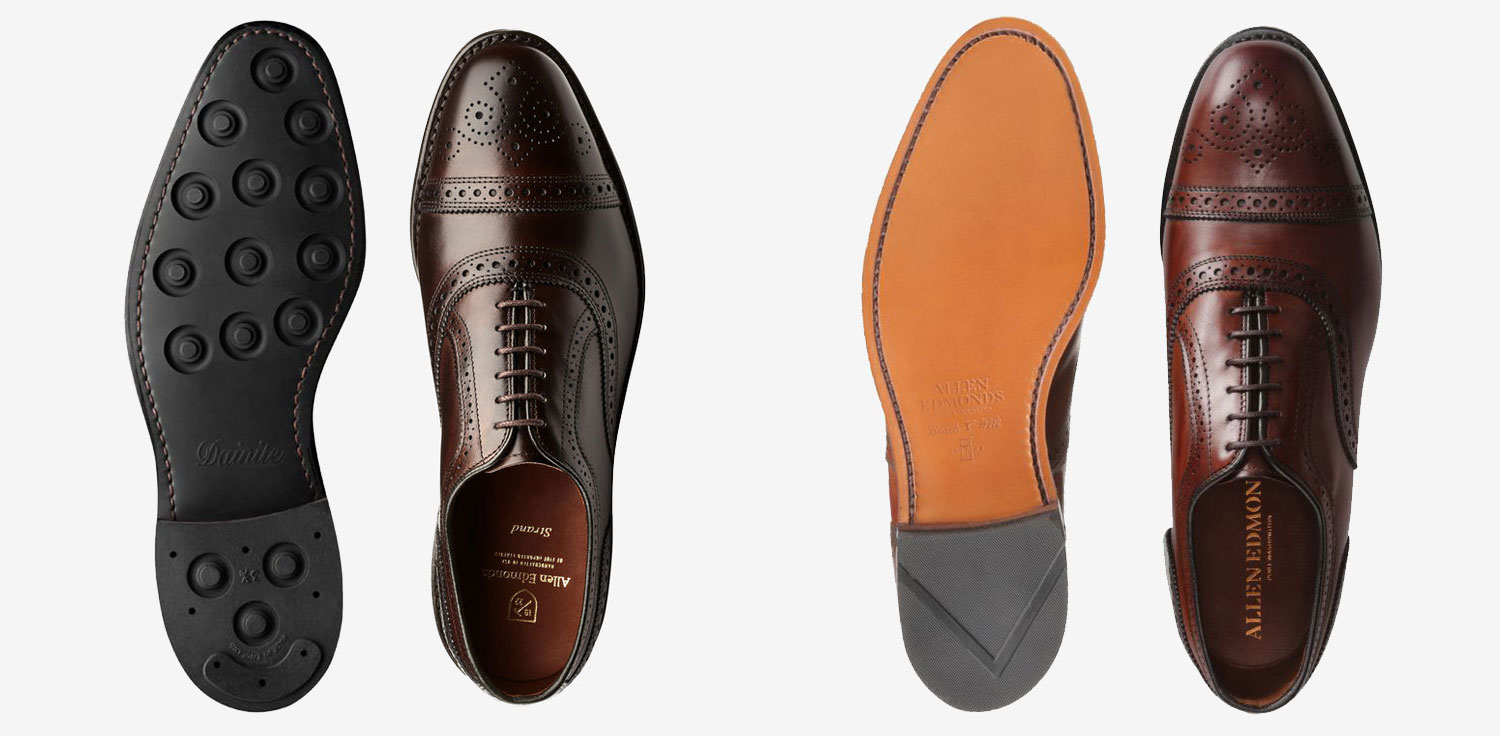
- Leather – Lowest profile, least weather-resistant. Sleek, handsome, and elegant with a good feel and sound. If you want a classic pair of dress shoes, this is your choice.
- Dainite – Dainite soles have a lower profile and more polished look than you get from typical rubber soles. They’re a good compromise if you’re going to do a lot of walking around the city in your dress shoes but still need a formal look.
- Rubber – Grippy and rugged, yes. Dressy and formal… not so much. Rubber soled dress shoes tend to be thick and protruding – they’re best for shoes designed to withstand the weather and grip any kind of terrain.
Again, go with the best if you want a quality pair of brown dress shoes that will last for a decade (or more). Leather soles are by far the most professional, formal, and classic option for dress shoes. Avoid rubber – it just doesn’t fit in with a handsome shoe.
Brown Leather Dress Shoes: Here’s What To Buy
At this point you’ve learned all the pertinent details about dress shoes. Now it’s time to choose the right pair for you… the shoes that will take your professional outfit from dull to dapper.
This buying guide is based on all the factors above: the style, construction, and quality that make a pair of brown dress shoes worth your money and worth wearing for years to come.
Think of this guide as a jumping-off point to help you find the right pair. Check out my suggestions to figure out what appeals to you.
My hope is that these options help you narrow down your preferences and choose a pair of shoes that work for your style.
But there’s another major factor you can’t forget about…
How Much To Spend On Brown Leather Shoes
Time for some real talk.
If you want long-lasting, quality dress shoes from a reputable brand, expect to spend at least $300 (full price retail). There’s a reason a good shoe costs this much: the quality of the material and the quality of the construction (and to some extent, the brand cache).
Frugal gents, I know this can be hard. But saving a few dollars isn’t worth walking around in a subpar shoe. You won’t be as satisfied with your purchase because:
- Cheap leather dress shoes look worse the more you wear them, and
- You’ll have to replace cheap shoes more frequently because they fall apart.
Cheap vs Expensive Dress Shoes?
If you’re going to fork out $150 for a pair of cheap dress shoes, hold out for a bit longer and save up an extra $150 to get a better pair. There’s a big difference between a pair you can buy for $150, and one that runs you $300+.
Cheap leather dress shoes don’t age gracefully and look terrible over time. But quality, full-grain leather dress shoes look better as they age and develop a unique patina. Here’s more info on building a patina over time.
Average the cost over the total days you will use this new pair of dress shoes. You’ll find that spending $300 isn’t outlandish, especially since you’ll be able to use these shoes for years, maybe even decades.
But let’s suppose you do have to replace them. A quality pair can be repaired, resoled, and refinished… all for less than buying a new pair of shoes.
Bottom Line: Spending more now will save you money in the long term, and best of all, you’ll enjoy the experience every time you wear the shoes.
EG Recommends These Brown Dress Shoes
Here are a few brands I own, have tried, and / or generally just love. You can’t go wrong with any of these.
Make a memorable impression with the refined elegance of the cap toe Allen Edmonds Strand lace-up oxford
Oak Street Bootmakers has handcrafted 100% of their footwear and accessories in the United States since 2010
Ace Marks is a reasonably priced, cleverly contemporary, utterly luxurious and comfortable dress shoe
Meermin is a decades-old, family-owned and operated business based in Mallorca, Spain, specializing in well-made Goodyear welted shoes.
I listed shoes across the price spectrum that give you great value for your hard-earned cash.
What if you simply cannot afford a great pair at this time?
Then you’ll have to find a shoe that looks visually similar to the ones I’ve mentioned above and do the best you can to take care of them.
You’ll sacrifice quality and longevity at lower price points, but if you keep them clean and put shoe trees in them after every use, they’ll last a bit longer than if you didn’t care for them.
Remember: Your wardrobe is an investment. Go classic. And when possible, buy good quality once and wear forever.
Shoes are one of the things I encourage you to spend a bit more on. They tend to last longer and look great throughout the years, assuming you take proper care of them.
How to Care for Your Brown Leather Dress Shoes
Don’t let your shoes go to waste after all the hard work you put into choosing the right pair. You need to take care of your leather shoes.
Fortunately, this part is easy. A few small purchases and good habits will ensure your dress shoes always look great.
Shoe Trees
While not in use, your brown dress shoes should be kept flat on their soles, with cedar shoe trees inserted. Do not just throw your beautiful new shoes in the closet. Ever.
Shoe trees are molds of the general form of a foot that help maintain your shoe’s shape and fight the creases. They come in different materials, but cedar is the only one you should consider – it’s great at absorbing moisture and keeping moths away.
Before you buy, remember that shoe trees are not one-size-fits-all.
- If you buy them too large or too wide, they can stretch and damage your shoe’s leather.
- Too small or narrow, they won’t provide the necessary support and you’ll risk the shoe losing its form.
Try the shoe trees first if possible and make sure they fit snugly in your shoes, but not so tight you have to jam them in.
Shoe Polish
Shine your dress shoes at least once every other week (assuming you use them regularly) to maintain the leather and keep them in top form.
The Ultimate Shoe Care Kit via Beckett Simonon: Keep your shoes in their best condition possible with the Saphir Set of luxurious products. Saphir is the world-leader in shoe care.
Comes with Saphir's Waterproofing Spray, Cream Shoe Polish (colors included are black, tan, oak, brown and bordeaux), Creme Universelle, and Horsehair Brush.
If you wear these shoes regularly, go over them for a few minutes with a horsehair brush or soft cloth to keep them looking smart between polishes.
This simple shoe polish kit from Saphir is perfect for your high quality leather shoes. It includes everything you need to properly care for your investment-quality dress shoes.
You’re going to want to:
- Lift away any dirt or dried mud with a semi-coarse brush (horsehair, ideally)
- Select and apply the proper color polish (brown or neutral, depending on the shade of your shoes)
- Work the polish into the leather with a softer brush
- Finish by going over each shoe with a soft cloth
- Buff out any polish by briskly brushing the shoe with the horsehair brush
I recommend following channels such as Kirby Allison and The Elegant Oxford for excellent shoe shine tutorials.
Rotate your shoes
Even shoe trees and regular polishing won’t save your shoes if you never give them a day off.
Rotating your shoes lets them dry and ensures they last longer. Even if you only switch between two pairs of shoes, you can potentially double the lifetime of each.
What to Wear with Brown Leather Dress Shoes
You’ve got a killer pair of brown dress shoes that you’re taking great care of. But what should you wear them with to look your best?
Good news: brown dress shoes are extremely versatile. They go with just about everything. Here are some examples for both formal and smart casual attire, and more proof that brown shoes are more adaptable than black.
Related Articles on EG (don’t miss these)
- How To Match Clothing Well
- How To Use Contrast To Create Kick-Ass Clothing Combinations
- Choose The Best Clothing Colors For Your Skin Tone
- How To Match Clothes: Quick and Easy Color Combos
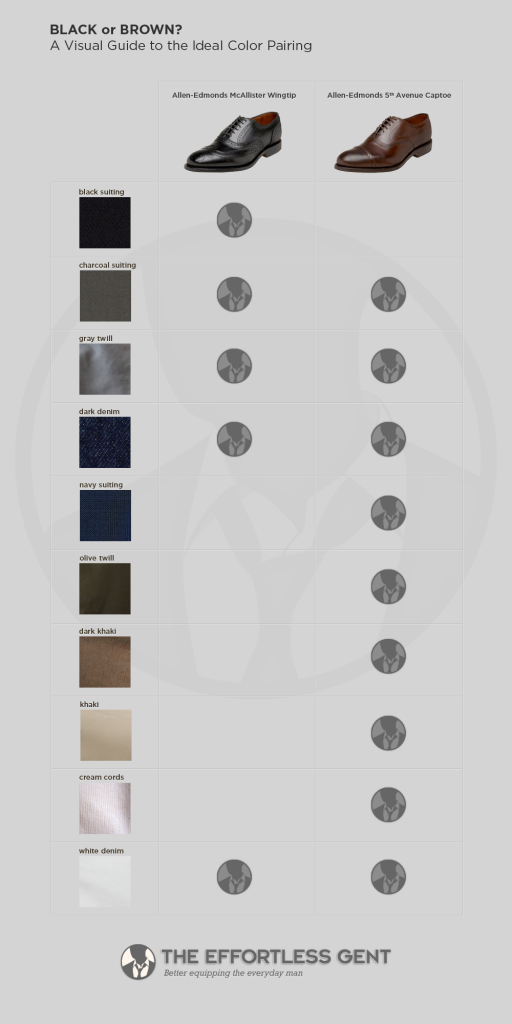
Suiting
- Gray/Charcoal – Brown warms up the palette. Dark, rich browns look best.
- Navy/Blue – Any shade of brown contrasts beautifully with a navy suit. Lighter tones – tan, cognac, walnut, etc. – stand out well against darker navy but also work with lighter blues.
- Tan/Khaki – Any shade will work. For a dressier look, choose shoes one tone darker than your suit.
- Black – Here’s one of the few cases where brown won’t work. Yes, some guys will try to pull off brown shoes with a black suit. But in general, it’s a bad idea.
Chinos & Denim
Brown leather dress shoes elevate your smart casual and business casual style. You’ll most likely be wearing chinos or denim in these situations. Brown shoes work well with:
- Olive Chinos
- Dark Khaki Chinos
- Medium Khaki Chinos
- Cream Chinos
- Dark Denim
- White Denim
Mix & Match
These color combinations are just a place to start – not hard and fast rules. In theory, either brown or black shoes can go with any pant color.
But what looks best also depends on what
Want to mix it up and get creative? Try this:
- If you typically play it safe (i.e. black lace-ups with dark denim and a black button-up), try out your pair of brown wingtips with a lavender
shirt . - Swap out that black button up for a dark red / white bengal stripe
shirt . - Swap the dark denim for an olive
gingham .
Lots of options pair nicely with brown shoes. You owe it to yourself to try them out!
FAQs
Can you wear brown shoes to a wedding?
Unless it’s black tie or white tie, yes. Just follow the guide above regarding the color of your
Can you wear brown shoes with a tuxedo?
The only tuxedo you can pair with brown shoes is a dark navy one, and the shoes should be, not only the darkest brown, but also the most minimal design as well. Think, a whole-cut plain-toe Oxford shoe.
Should you match your leather belt with your shoes?
Yes, if you’re wearing dress shoes and a belt, they should match each other.
In Summary: Everything You Need To Know About Brown Dress Shoes
Here’s a quick roundup of everything you need to know about brown leather dress shoes – both before you buy and after you’ve chosen the perfect pair:
- A shoe’s style, color, and broguing all affect how formal they are and what outfits they’ll look best with.
- Full grain leather uppers, leather soles, and Goodyear welting or Blake stitching make for a pair of classic dress shoes that will last for years to come.
- Care for your shoes – rotate them out every other day or so, store them with shoe trees, and polish them once each week.
- Brown dress shoes go with everything from
suits to smart casual attire. If you’re feeling unsure about what to wear them with, match the formality of your shoes to that of your outfit and surroundings.
I hope this guide has helped you find the right pair of brown leather dress shoes.
Make sure they’re quality and always take good care of them. That way you’ll be satisfied with your purchase and can enjoy investment-worthy shoes for years to come.
What are your best tips for choosing brown dress shoes? How about your favorite styles or outfit combinations? Let me know!
If you have any questions or comments, hit me up on Twitter. You can also find join other readers on Effortless Gent’s Facebook page, or DM me on Instagram!

